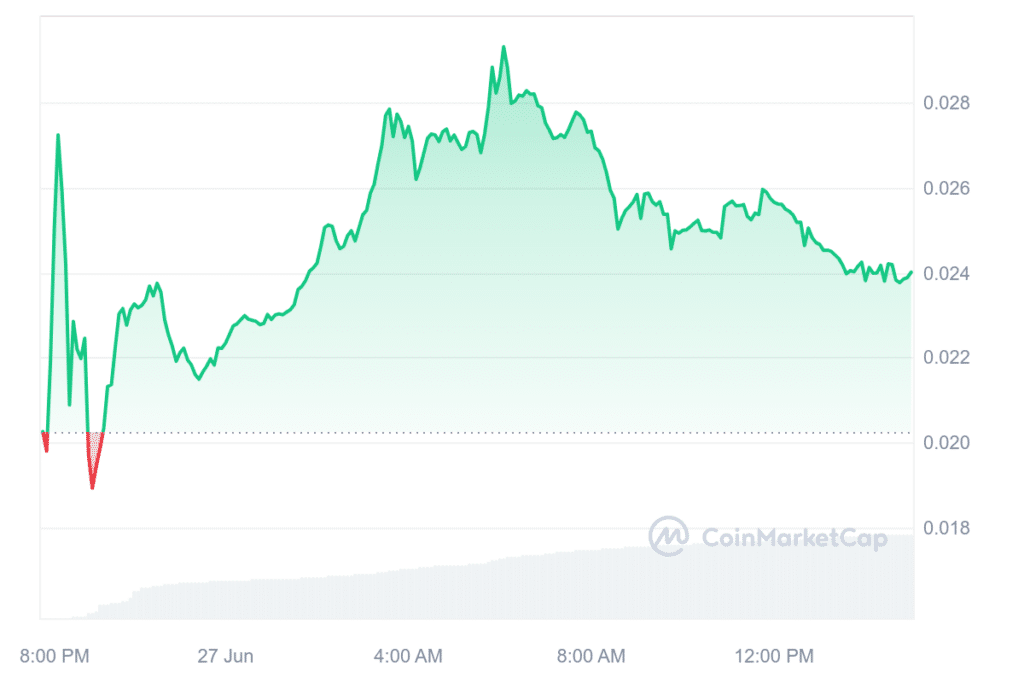BLAST Token Jumps 20% As Fake Airdrop Scams Flood X
BLAST, the native token of Ethereum layer-2 scaling solution Blast, surged 20% following its launch while a deluge of fake airdrop posts flooded X.
BLAST debuted at $0.02 per token, giving it a fully diluted value (FDV) of $2 billion at launch, according to aggregated data from Ambient Finance and the perps trading platform Aevo.
Created by makers of the incentivized NFT marketplace Blur, Blast’s distribution yielded an initial market cap of $392 million.
BLAST’s price has now risen slightly more than 20% to $0.024 at the time of publication, according to CoinMarketCap data. The crypto asset now has a market capitalization of $408 million and a daily trading volume of $730 million.

The airdrop released 17% of BLAST’s total supply, with 7% allocated to users who bridged Ether or USD on Blast (USDB) to the network since late last year.
Another 7% was distributed to users who contributed to the success of decentralized applications (dApps) on the network, and 3% was reserved for the Blur Foundation for future community airdrops.
Blast, created by the makers of the incentivized NFT marketplace Blur, faced significant challenges from scammers on social media.
Numerous fraudulent posts claimed that Blast’s airdrop had started sooner than expected. These posts, bearing the same profile picture and display name as Blast’s legitimate X account, directed users to fake websites and boasted “Gold checkmarks” introduced by the platform’s current owner, Elon Musk.
Some of these suspicious links even infiltrated Blast’s official Discord server before being removed by a community moderator.
One victim reportedly lost $217,000 worth of crypto after visiting a phishing site, as detailed by the cybersecurity firm Scam Sniffer. The user had unknowingly signed multiple malicious transactions, highlighting the ongoing challenges in combating bad actors on the platform.
Despite the airdrop’s success in distribution, it attracted criticism from market commentators on X, particularly regarding the absence of a staking mechanism for BLAST tokens.
Moreover, some BLAST token holders expressed intentions to sell their airdropped tokens immediately upon the opening of perpetual markets.
Blast’s airdrop marks the second Ethereum layer-2 blockchain airdrop in June, following the zkSync airdrop earlier in the month.
The zkSync token distribution faced heavy criticism from the community, with claims that many users were left out in favor of Sybil addresses—multiple wallets created by the same user to claim a large number of tokens.
Ether Surges 16% Amid Speculation Of US ETF Approval
New York, USA – Ether, the second-largest cryptocurrency by market capitalization, experienced a significant surge of ... Read more
BlackRock And The Institutional Embrace Of Bitcoin
BlackRock’s strategic shift towards becoming the world’s largest Bitcoin fund marks a pivotal moment in the financia... Read more
Robinhood Faces Regulatory Scrutiny: SEC Threatens Lawsuit Over Crypto Business
Robinhood, the prominent retail brokerage platform, finds itself in the regulatory spotlight as the Securities and Excha... Read more
Ethereum Lags Behind Bitcoin But Is Expected To Reach $14K, Boosting RCOF To New High
Ethereum struggles to keep up with Bitcoin, but experts predict a rise to $14K, driving RCOF to new highs with AI tools.... Read more
Ripple Mints Another $10.5M RLUSD, Launch This Month?
Ripple has made notable progress in the rollout of its stablecoin, RLUSD, with a recent minting of 10.5… Read more
Bitcoin Miner MARA Acquires Another $551M BTC, Whats Next?
Bitcoin mining firm Marathon Digital Holdings (MARA) has announced a significant milestone in its BTC acquisition strate... Read more

